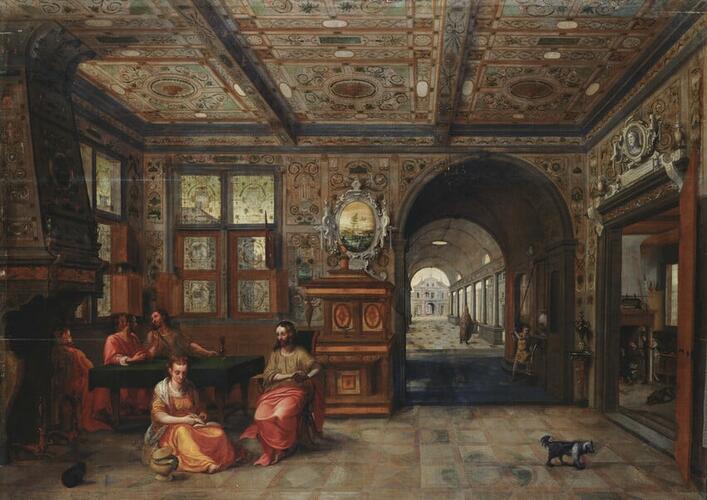-
1 of 253523 objects
Christ in the House of Martha and Mary Signed and dated 1566
Oil on panel | 79.4 x 109.2 cm (support, canvas/panel/stretcher external) | RCIN 405475
-
St Luke's Gospel (Luke 10: 38-42) tells of Jesus visiting the house of Martha and her sister Mary. Martha chides her sister for listening to Christ and not helping in the kitchen; Jesus replies, 'Martha, Martha, thou art careful and troubled about many things: but one thing is needful: and Mary hath chosen that good part, which shall not be taken away from her.'
When imagining the biblical scene, it is natural to think of a humble dwelling with no servants to help Martha in her frantic preparations. De Vries was a specialist in architecture and perspectival illusionism, who chooses instead to set the scene in a chamber of luxurious splendour, the walls and ceiling covered in panelling embellished with sophisticated decoration. Three mini-images are included: a landscape painting over the mantelpiece, a depiction of the Sacrifice of Isaac over the buffet (cupboard), and a bust of Moses over the right-hand doorway. De Vries creates a perfect illusion of precisely articulated space filled with air and light, capturing the effect of daylight streaming through the colonnade and the kitchen window and the way in which the stained glass to the left seems to merge with the building seen through it. This interior is reminiscent of a precious jewel box.
Mary sits 'at Jesus' feet' on a low stool, absorbed by her book and neglecting her workbox. Three characters - presumably disciples - appear behind, two arguing and one sleeping. In the kitchen to the right a man sits by the fire whilst a woman leans towards him holding a ladle (the attribute of Martha). Two further figures in the background - a boy drawing water from a well and a man (possibly a Pharisee) walking through the colonnade - facilitate the illusion of the picture plane receding far into the distance.
X-radiographs reveal that all the major figures have been painted over. Originally Martha occupied the centre foreground, while Christ and Mary looked up towards her. It was only when the standing figure was eliminated that the woman in the kitchen area was given Martha's attribute. The overpainting was possibly carried out by the artist Anthonis Blocklandt, at the behest of the owner, only a few years after completion. This implies that de Vries was not considered to be a master painter of the human form, and it is possible that he had not been responsible for the figures in the first place, drafting in a 'figure expert' instead. The removal of Martha from the foreground enabled a clear view through the archway to the impressive barrel-vaulted colonnade and buildings beyond, thereby shifting the emphasis from the religious scene to the magnificent architectural setting.
Dated 1566 on the step below the archway; incomplete signature in Greek and Latin letters
Catalogue entry adapted from Bruegel to Rubens: Masters of Flemish Painting, London, 2007Provenance
Henry, Prince of Wales; Anne of Denmark; by descent to Charles I; sold for £6 to Emanuel de Critz and others on 18 November 1651 (no 337); recovered at the restoration and listed in te Withdrawing Room at Whitehall in 1666 (no 92)
-
Creator(s)
-
Medium and techniques
Oil on panel
Measurements
79.4 x 109.2 cm (support, canvas/panel/stretcher external)
96.1 x 125.1 x 7.7 cm (frame, external)
